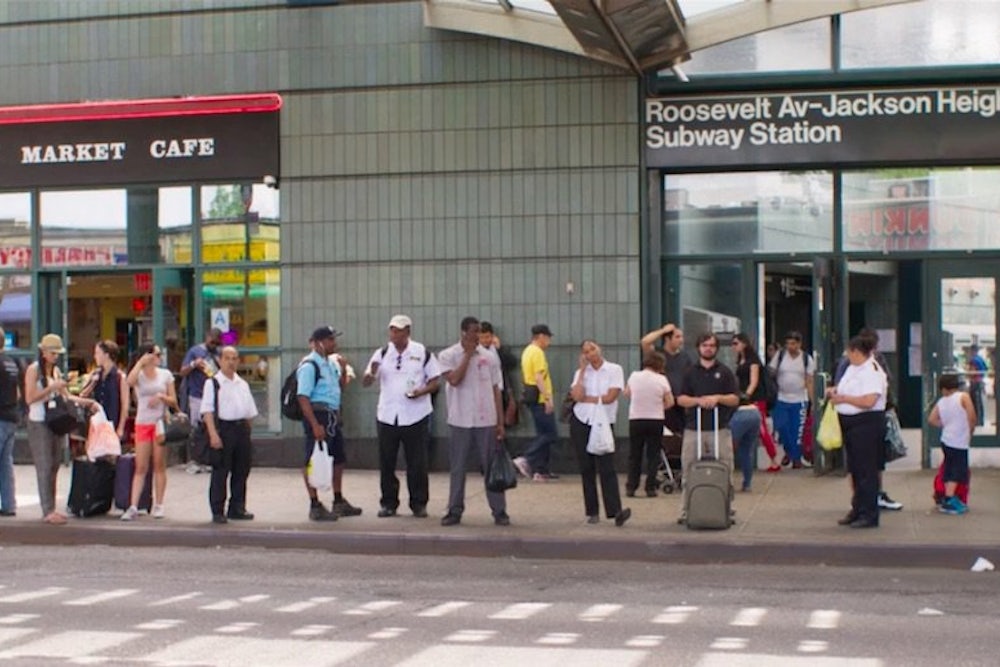From Grand Central Station, the geographic heart of Manhattan, a 20 minute express subway ride on the elevated 7 train delivers you into the bosom of Jackson Heights, the spiritual heart of Queens and the setting for legendary documentarian Frederick Wiseman’s latest meditation on an American institution. In Jackson Heights, the director’s forty-third feature film, never takes us on that intraborough subway ride, but the effect of people taking it for the first time, in pursuit of fertile territory to “develop”, is felt throughout the remarkably heterogenous community that is at the center of Wisemen’s kaleidoscopic most recent documentary of place.
The close knit, small town vibe of the Jackson Heights is established in an early passage: Wiseman films New York City Councilman Daniel Dromm at a luncheon preceding an LGBTQ parade, as Dromm speaks about the recent murder of a person he knew, one both homosexual and homeless and killed because of it. The councilman lauds members of the community of over a half dozen different nationalities and racial identities and sexual orientations who came together in the aftermath; and then Dromm acknowledged how LGBTQ youth in Jackson Heights had “never known that hatred and that prejudice in this community because of the visible presence of LGBT here. We’re just interwoven.” He reminds us that Jackson Heights is “the most diverse community in the whole world, literally,” home to 167 different languages and perhaps as many ethnicities. It’s a place where starkly different people are forced to get along—at least for the time being.
Wiseman’s film don’t have central conflicts and main characters; his films take on themes gradually as they revisit characters and spaces. He and his small crew meander around the margins of the scene at hand, finding just the right frame to capture a particular moment that may or may not reflect on an earlier one or broaden our understanding of the system or social structure Wiseman has set out to unearth. The ways multiple generations of LGBT and gentrification activists organize, the simple lived moments of street sweepers, the way church ladies and women with parents dying of cancer bond on a random corner—these glimpses of common neighborliness fuel a portrait that is rarely dramatic in its parts, but proves quite moving as a whole. Whether it’s anxieties that undergird a neighborhood business association meeting or the rambling nature of a recent immigrant reciting her American origin story, in Jackson Heights Wiseman glimpses both how an unusually diverse place provides safety and sanctity for a variety of its commingling communities while detailing how the seemingly unstoppable tide of widespread gentrification will swallow it whole.
Wiseman, who was the subject of a year long, thirty-six film retrospective at the Museum of Modern Art in New York in 2010, has been telling stories of the way America works for so long that he’s assured a place on the Mount Rushmore of documentary filmmaking. America’s great chronicler of institutions has been making purely observational documentaries with self-explanatory titles—State Legislature (2006), High School (1968), Basic Training (1971), Juvenile Court (1973), and Boxing Gym (2010)—since the Johnson Administration, and his movies have touched on hot button topics from the very beginning. Wiseman’s “burlesque at the nuthouse” debut Titicut Follies (1967), completed in the dying days of American film censorship, was nearly subject to a ban from the State of Massachusetts before its screening at the 5th New York Film Festival. Even so, In Jackson Heights is the most complex subject the filmmaker ever attempted.
The task of documenting such a vast and inclusive community might not be beyond Wiseman, but totality is elusive. Jackson Heights, as a neighborhood of 130,000 people, is simply too big to distill. That doesn’t mean the movie is a failure; Wiseman’s multifaceted look at the neighborhood is as consistently fascinating, across its 190 minutes, as the neighborhood it documents. But to this critic’s dismay, one never meets the forces that threaten the neighborhood, the uncaring faces that represent the unquenchable desire for capital to replicate itself. Where are the developers that we hear so much of from in barbershops and cuchifritos joints along the Roosevelt Avenue corridor? Wiseman is not much interested in traditional conflicts, but the face of the villain in this case remains so amorphous, not just in this film but around conversation concerning gentrification in general, that it would have been nice to visit the office of a Caldwell Banker or a brand new condominium.
To suggest that the movie reveals gentrification for what it really is—class warfare dressed in the cultural tastes of so called progressives—is a facile reading, but it is strongly implied in many of the film's most salient passages. You’ll also see the generosity of spirit that emboldens the communities long standing structures to resist the invasion. While Wiseman’s camera listens to restauranteurs and salon owners’ nervous conversations about the millennial liberals who will surely flock to the neighborhood’s new condos (“gringos,” they’re referred to by one organizer), one gets the sense that whatever replaces these people and the structures they have built to sustain themselves will be less likely to themselves share a culture. I suppose bourgeois bohemians and wealthy recent college grads are united by $16 cocktails and artisanal, gluten free bread. But they are less likely to be imbued with a enduring sense of communal purpose and the ethos of multi-ethnic, intra-class acceptance that pervades central Queens.
The neighborhood won’t go down without a fight, though, and many of the film’s most riveting scenes involve discussion between organizers and small business people who run the type of shops that serve this vast community with an intimacy that the chain stores and boutiques that threaten their existence will not. In documenting this process, Wiseman’s work takes on the moral density of a Dickens novel. It’s smart enough to find the moments that show our civilization, as big and complex and troubled as it is, is still worth fighting for.
